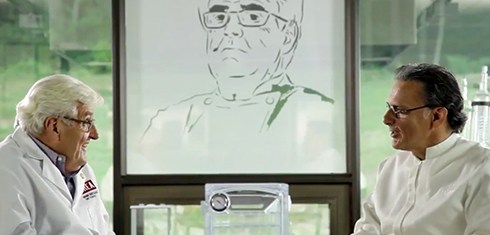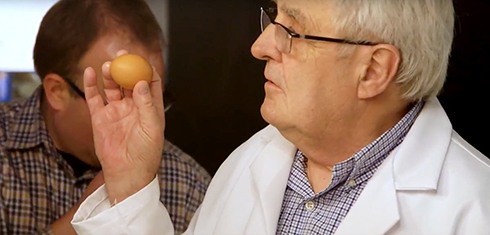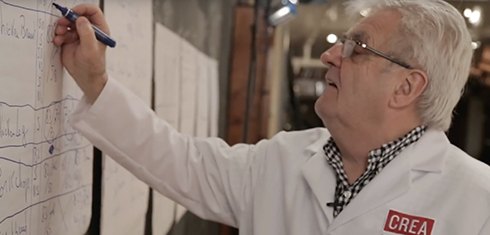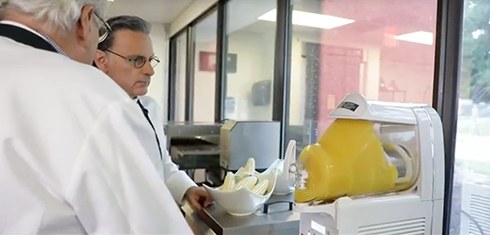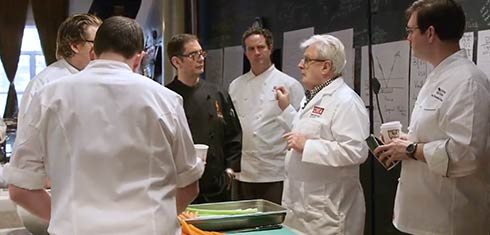“My biggest goal during my life has changed. At the beginning of my job I wanted to be the best scientist in the world. Now I want to spend the rest of my life transmitting my knowledge.”
DR. BRUNO GOUSSAULT , SOUS VIDE PIONEER

Dr. Bruno Goussault is recognized as the founder of modern sous vide. In 1971, Dr. Goussault developed sous vide as a way of improving the tenderness of roast beef. Dr. Goussault discovered that if the beef was vacuum-sealed in a specially designed pouch and slowly cooked at a slightly-lower-than-usual temperature, it showed little sign of profit-robbing shrinkage compared to conventional cooking methods. Plus, the flavor was notably enhanced. This was the birth of the new technology of sous vide, and it was quickly adopted by top chefs throughout Europe. Today, as the chief scientist at Cuisine Solutions, Dr. Goussault continues to refine this revolutionary water bath cooking method—and share his knowledge with world-renowned and up-and-coming chefs alike. He founded the Culinary Research & Education Academy (CREA), where he has taught more than 80 percent of chefs with three Michelin stars, including Thomas Keller, Daniel Boulud, Yannick Alléno, Joël Robuchon, and Anne-Sophie Pic, as well as the next generation of chefs. Dr. Goussault sits on the board of the Association des Chimistes (Association of Chemists) and Ingénieurs et Cadres des Industries Agricoles et Alimentaires (Engineers and Managers of Agricultural and Food Industries), and was recently selected for the prestigious Albert Einstein Legacy Project’s Genius: 100 Visions of the Future initiative.
Conversations with the Master
Master Class with Chef Marc Ehrler
In this conversation with chef Marc Ehrler, VP of Culinary at Hilton, we explore Dr. Bruno Goussault’s introduction to sous vide and the qualities that make a great chef.
Joël Robuchon & the Perfect Egg
In the second installment of our conversation between sous vide pioneer Dr. Bruno Goussault and chef Marc Ehrler, the two discuss the development of the perfect egg and the role of chef Joël Robuchon.
The Curiosity of a Chef
In the third installment of our series between sous vide pioneer Dr. Bruno Goussault and chef Marc Ehrler, Dr. Goussault explains that necessity is the mother of invention.
Why Food Science?
In the fourth installment of our series between sous vide pioneer Dr. Bruno Goussault and chef Marc Ehrler, the two discuss Dr. Goussault’s attraction to food science (hint: it all started in Africa) and how cryoconcentration makes something extraordinary from food waste.
Sous Vide and Plant-Based Foods
In the fifth installment of our series between sous vide pioneer Dr. Bruno Goussault and chef Marc Ehrler, Dr. Goussault explains how, for him, vegetables are one of the most exciting areas of exploration for sous vide and its use in sustainability.
FAQ with Dr. Bruno Goussault
Any advice for those thinking of trying sous vide for the first time?
Sous vide is a process of cooking, and you still need to respect the same traditions and standards. What is good in a traditional kitchen is also good in sous vide cooking.
How do results differ between conventional and sous vide cooking?
People love sous vide because of the flavors and textures it provides. Nothing leaves the food when you use the sous vide method. All of the flavor is concentrated. Nothing is lost.
What’s the most important tip for someone cooking an egg sous vide for the first time?
Raising the temperature to achieve your desired texture and firmness faster won’t work. Always consider both time and temperature when you’re cooking sous vide eggs—or for any sous vide cuisine.
Many readers have said that they only cook proteins using sous vide, because it seems easier. What’s the benefit of cooking vegetables using the method?
It seems like nobody works with vegetables with the same attention as they do meat. That may be because you have a lot of people who believe that vegetables have no taste. But it’s just not true. What we’re doing today is discovering new ways to enhance the flavor of vegetables—to give them the best taste when cooked at a precise temperature. It’s about finding the localization of flavor—is it in the root, stem, or leaves? Is it in the core or the periphery? We are testing all of it to find out where the best flavor is.
What is the most unusual or surprising food that you’ve cooked sous vide?
Watermelon comes to mind. You open a new avenue or a new world—a new texture, a new taste, a new something—and the results you obtain with sous vide are sometimes ones that you have never encountered before. Also, I love celery root because it transforms into something with the texture of a scallop.
Why do you use precise temperatures?
You cook to obtain a result. When you work at precise temperatures, you’re addressing things like the color and tenderness as well as the water-holding capacities of the food. When you cook vegetables, like carrots, you can play around with finding just the right temperature and time because sometimes you want the crunch while wanting them to be cooked. This is possible with sous vide.
What is happening to meat on a molecular level when you cook it sous vide?
Beef tenderloin, for example, has long fibers. When you cook it, the time of cooking is long because the heat needs to pass from one fiber to another. And when you cook under pressure, the meat can’t grow. So, the retraction of the connective tissue must happen differently than with just cooking over a flame in a traditional way. The results are a more tender, juicy, and flavorful cut of meat.
What’s your No. 1 rule for the lab?
Precision and accuracy, with everything. That translates into cleanliness and attention to detail. I’m a scientist, so I look at sous vide in a scientific way.
Ask a Question
Submit your question for Dr. Bruno Goussault using the form below.
